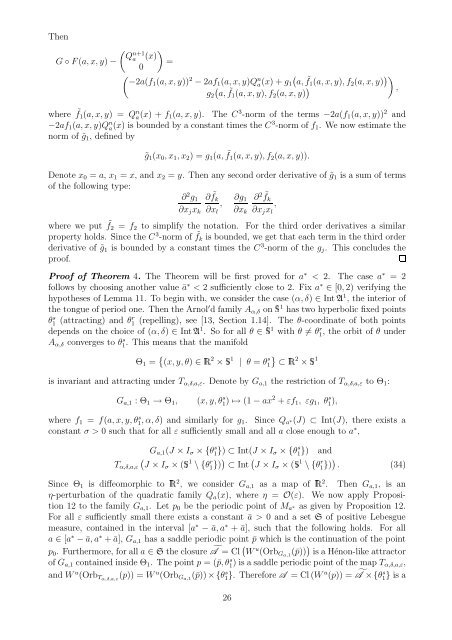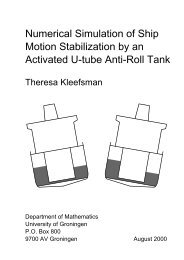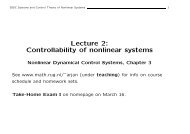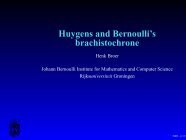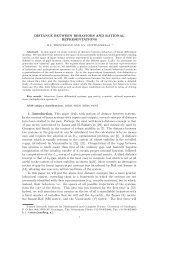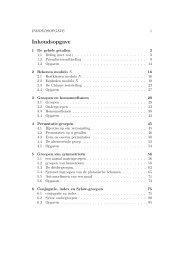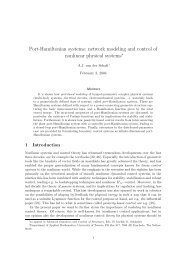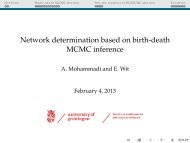Chaos and quasi-periodicity in diffeomorphisms of the solid torus
Chaos and quasi-periodicity in diffeomorphisms of the solid torus
Chaos and quasi-periodicity in diffeomorphisms of the solid torus
You also want an ePaper? Increase the reach of your titles
YUMPU automatically turns print PDFs into web optimized ePapers that Google loves.
Then<br />
G ◦ F (a, x, y) −<br />
( ) Q<br />
n+1<br />
a (x)<br />
=<br />
0<br />
( −2a(f1 (a, x, y)) 2 − 2af 1 (a, x, y)Q n a (x) + g 1(<br />
a, ˜f1 (a, x, y), f 2 (a, x, y) ) )<br />
(<br />
g 2 a, ˜f1 (a, x, y), f 2 (a, x, y) ) ,<br />
where ˜f 1 (a, x, y) = Q n a(x) + f 1 (a, x, y). The C 3 -norm <strong>of</strong> <strong>the</strong> terms −2a(f 1 (a, x, y)) 2 <strong>and</strong><br />
−2af 1 (a, x, y)Q n a (x) is bounded by a constant times <strong>the</strong> C3 -norm <strong>of</strong> f 1 . We now estimate <strong>the</strong><br />
norm <strong>of</strong> ˜g 1 , def<strong>in</strong>ed by<br />
˜g 1 (x 0 , x 1 , x 2 ) = g 1 (a, ˜f 1 (a, x, y), f 2 (a, x, y)).<br />
Denote x 0 = a, x 1 = x, <strong>and</strong> x 2 = y. Then any second order derivative <strong>of</strong> ˜g 1 is a sum <strong>of</strong> terms<br />
<strong>of</strong> <strong>the</strong> follow<strong>in</strong>g type:<br />
∂ 2 g 1 ∂ ˜f k ∂g 1 ∂ 2 ˜fk<br />
,<br />
,<br />
∂x j x k ∂x l ∂x k ∂x j x l<br />
where we put ˜f 2 = f 2 to simplify <strong>the</strong> notation. For <strong>the</strong> third order derivatives a similar<br />
property holds. S<strong>in</strong>ce <strong>the</strong> C 3 -norm <strong>of</strong> ˜f k is bounded, we get that each term <strong>in</strong> <strong>the</strong> third order<br />
derivative <strong>of</strong> ˜g 1 is bounded by a constant times <strong>the</strong> C 3 -norm <strong>of</strong> <strong>the</strong> g j . This concludes <strong>the</strong><br />
pro<strong>of</strong>.<br />
Pro<strong>of</strong> <strong>of</strong> Theorem 4. The Theorem will be first proved for a ∗ < 2. The case a ∗ = 2<br />
follows by choos<strong>in</strong>g ano<strong>the</strong>r value ā ∗ < 2 sufficiently close to 2. Fix a ∗ ∈ [0, 2) verify<strong>in</strong>g <strong>the</strong><br />
hypo<strong>the</strong>ses <strong>of</strong> Lemma 11. To beg<strong>in</strong> with, we consider <strong>the</strong> case (α, δ) ∈ Int A 1 , <strong>the</strong> <strong>in</strong>terior <strong>of</strong><br />
<strong>the</strong> tongue <strong>of</strong> period one. Then <strong>the</strong> Arnol ′ d family A α,δ on 1 has two hyperbolic fixed po<strong>in</strong>ts<br />
¡<br />
θ1 s (attract<strong>in</strong>g) <strong>and</strong> θ1 r (repell<strong>in</strong>g), see [13, Section 1.14]. The θ-coord<strong>in</strong>ate <strong>of</strong> both po<strong>in</strong>ts<br />
depends on <strong>the</strong> choice <strong>of</strong> (α, δ) ∈ Int A 1 . So for all ¡ θ ∈ 1 with θ ≠ θ1 r , <strong>the</strong> orbit <strong>of</strong> θ under<br />
A α,δ converges to θ1 s . This means that <strong>the</strong> manifold<br />
Θ 1 = { }<br />
(x, y, θ) ∈ 2 × 1 | θ = θ1<br />
s ¡ ⊂ 2 1<br />
¡ ×<br />
is <strong>in</strong>variant <strong>and</strong> attract<strong>in</strong>g under T α,δ,a,ε . Denote by G a,1 <strong>the</strong> restriction <strong>of</strong> T α,δ,a,ε to Θ 1 :<br />
G a,1 : Θ 1 → Θ 1 , (x, y, θ s 1 ) ↦→ (1 − ax2 + εf 1 , εg 1 , θ s 1 ),<br />
where f 1 = f(a, x, y, θ s 1 , α, δ) <strong>and</strong> similarly for g 1. S<strong>in</strong>ce Q a ∗(J) ⊂ Int(J), <strong>the</strong>re exists a<br />
constant σ > 0 such that for all ε sufficiently small <strong>and</strong> all a close enough to a ∗ ,<br />
G a,1 (J × I σ × {θ s 1 }) ⊂ Int(J × I σ × {θ s 1 })<br />
T α,δ,a,ε<br />
(<br />
J × Iσ × (¡ 1 \ {θ r 1 })) ⊂ Int ( J × I σ × (¡ 1 \ {θ r 1 })) . (34)<br />
S<strong>in</strong>ce Θ 1 is diffeomorphic to 2 , we consider G a,1 as a map <strong>of</strong> 2 . Then G a,1 , is an<br />
η-perturbation <strong>of</strong> <strong>the</strong> quadratic family Q a (x), where η = O(ε). We now apply Proposition<br />
12 to <strong>the</strong> family G a,1 . Let p 0 be <strong>the</strong> periodic po<strong>in</strong>t <strong>of</strong> M a ∗ as given by Proposition 12.<br />
For all ε sufficiently small <strong>the</strong>re exists a constant ā > 0 <strong>and</strong> a set S <strong>of</strong> positive Lebesgue<br />
measure, conta<strong>in</strong>ed <strong>in</strong> <strong>the</strong> <strong>in</strong>terval [a ∗ − ā, a ∗ + ā], such that <strong>the</strong> follow<strong>in</strong>g holds. For all<br />
a ∈ [a ∗ − ā, a ∗ + ā], G a,1 has a saddle periodic po<strong>in</strong>t ¯p which is <strong>the</strong> cont<strong>in</strong>uation <strong>of</strong> <strong>the</strong> po<strong>in</strong>t<br />
p 0 . Fur<strong>the</strong>rmore, for all a ∈ S <strong>the</strong> closure à = Cl ( W u (Orb Ga,1 (¯p)) ) is a Hénon-like attractor<br />
<strong>of</strong> G a,1 conta<strong>in</strong>ed <strong>in</strong>side Θ 1 . The po<strong>in</strong>t p = (¯p, θ1 s) is a saddle periodic po<strong>in</strong>t <strong>of</strong> <strong>the</strong> map T α,δ,a,ε,<br />
<strong>and</strong> W u (Orb Tα,δ,a,ε (p)) = W u (Orb Ga,1 (¯p)) × {θ1 s}. Therefore A = Cl (W u (p)) = Ã × {θs 1 } is a<br />
26<br />
<strong>and</strong>


